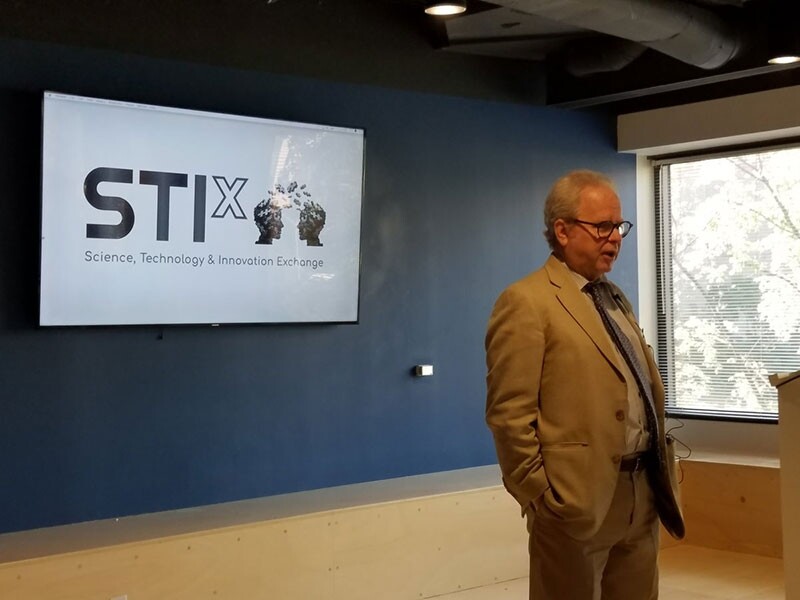
Robin Staffin speaking at DOD’s inaugural Science, Technology, and Innovation Exchange in August 2017.
(Image credit - DOD)

Robin Staffin speaking at DOD’s inaugural Science, Technology, and Innovation Exchange in August 2017.
(Image credit - DOD)
After serving in the position nearly a decade, Robin Staffin stepped down last month as director of the Department of Defense’s Basic Research Office. In an interview with FYI just prior to departing, Staffin described the office’s role in overseeing the department’s basic research portfolio and reflected on a career spanning physics, policy, and research administration.
Staffin stressed that the Basic Research Office is responsible for promoting work that has plausible relevance to the DOD mission but that has no immediate application in mind and is motivated primarily by scientists’ own interests. That mission sets the department’s basic research apparatus apart from other parts of its vast R&D enterprise, which focus on projects that anticipate a more direct benefit to the nation’s warfighters. Being aware of potential applications is fine, Staffin said, but ultimately DOD funds basic research with the belief that it is the broad portfolio, rather than particular projects, that will eventually pay dividends.
Although DOD spends far more
In addition to articulating overarching priorities and serving as a principal liaison with universities, Staffin said the office looks for gaps in the department’s basic research portfolio and potential duplication with other federal agencies. However, he said that the research arms of the military service branches have a great deal of autonomy in making funding decisions.
Staffin observed that the course of basic research tends to be in program managers’ hands, which he said is mostly a good thing. He also said that DOD is committed to not restricting the outputs of fundamental research, pointing to a 2010 memorandum
He noted that the Basic Research Office traces its roots to 1979, when it was created by Defense Secretary Harold Brown, whose own background was in physics. Its values, Staffin said, stem from the case made by Vannevar Bush for basic research in his landmark 1945 report
Nevertheless, Staffin said that it can be difficult to persuade researchers that DOD is genuinely interested in basic research, noting that many grant applications emphasize the potential applications of the proposed work. Worried that projects labeled as basic research were actually more applied in nature, Staffin conducted a review as part of a 2012 study
Acknowledging that basic research is not among the military’s foremost concerns, Staffin said that it has nevertheless been well supported. He noted that during his time as director, basic research received a budget boost under Defense Secretary Robert Gates, but also said he views funding stability as ultimately more important than the overall level.
Staffin described several activities and programs recently spearheaded by the Basic Research Office.
Last August, it convened the inaugural Science, Technology, and Innovation Exchange
As an example of how the office made use of a recent plus up in funds from Congress, Staffin cited two pilot programs: the Laboratory University Collaboration Initiative (LUCI) and the Defense Enterprise Science Initiative (DESI).
Launched in 2016, LUCI is designed
Staffin characterized his career as oscillating between research roles and positions oriented toward policy and administration.
He recalled that it was through his Ph.D. advisor at Stanford, Sidney Drell, that he learned of how physicists were influencing policy by serving on advisory groups such as JASON
After receiving his doctorate in particle physics in 1979, Staffin worked for a year in the Office of Technology Assessment. There he contributed to a study
He then joined Lawrence Livermore National Laboratory, researching plasma physics for over a decade before again pivoting to policy, working on nuclear weapons matters and serving as an advisor to Energy Secretary Bill Richardson. Returning to his particle physics roots, Staffin became director of the DOE Office of High Energy Physics in 2003, serving in that role until becoming director of the DOD Basic Research Office in 2008.
Staffin said that observing physicists such as Drell, Hans Bethe, and Richard Garwin engage with policy strongly influenced his own career choices, demonstrating to him that “scientists can have multiple lives.” Asked whether there is a new generation of people like Drell in the pipeline, Staffin said he is unsure, noting that Drell’s cohort emerged from the unique experiences of World War II and the Cold War. Nevertheless, he said he feels it is important for the country to have such a resource of technical talent willing to tackle problems of national importance.
More broadly, Staffin noted the intellectual challenges that can be found away from the lab bench, asserting, “Government is harder than physics.” Asked what advice he would give his successor, Staffin said to focus on what is important in the long term, concluding, “The rest is tactics.”
DOD has yet to select a new director. Bindu Nair, assistant director for human performance, training, and biosystems in the Office of the Assistant Secretary of Defense for Research and Engineering, is currently leading the Basic Research Office in an acting capacity.